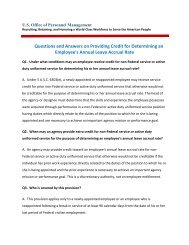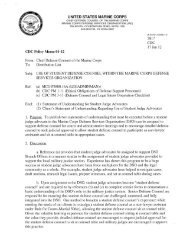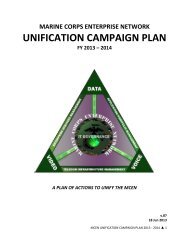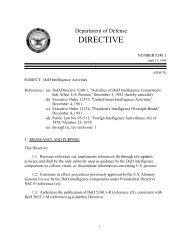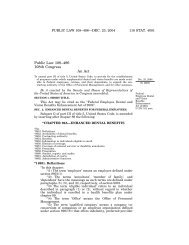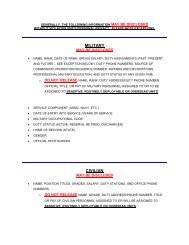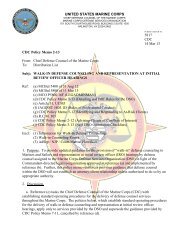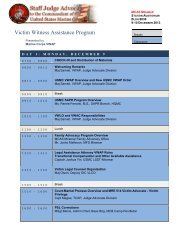FY2012 - Military Justice Report - Headquarters Marine Corps
FY2012 - Military Justice Report - Headquarters Marine Corps
FY2012 - Military Justice Report - Headquarters Marine Corps
You also want an ePaper? Increase the reach of your titles
YUMPU automatically turns print PDFs into web optimized ePapers that Google loves.
This Page Intentionally Left Blank
U.S. MARINE CORPS MILITARY JUSTICE REPORT FOR FISCAL YEAR 2012TABLE OF CONTENTSI. INTRODUCTION……………………………………………. 1II. BACKGROUND ……………………………………………... 1III. THE COMMANDANT’S REORGANIZATION………………… 1IV. MILITARY JUSTICE BY THE NUMBERS……………………. 6V. CONCLUSION………………………………………………. 13i.
U.S. MARINE CORPS MILITARY JUSTICE REPORT FOR FISCAL YEAR 2012I. INTRODUCTION.Fiscal Year 2012 was a year of great progress and change in the <strong>Marine</strong> <strong>Corps</strong> legalcommunity, which underwent a complete reorganization that will elevate the practice of law inthe <strong>Marine</strong> <strong>Corps</strong>. Aside from addressing metrics, this year’s military justice report will focuson the reorganization and its promise to improve practices, mentorship and training, and enhanceleadership.II. BACKGROUND.<strong>Military</strong> justice issues have been prominently featured in the news this past year.Misconduct on the battlefield, hazing, and sexual assault have all been highlighted in interestpieces, opinion pieces, and news items. Members of Congress have also expressed interest inhow the military addresses misconduct, and about the inner workings of the military justicesystem. Finally, the Secretary of Defense’s recent creation of the Defense Legal Policy Boardhighlights the additional attention being paid to the legal system and mission in the military.Against this backdrop, the <strong>Marine</strong> <strong>Corps</strong> acted to ensure our organization evolves to meet thecomplex challenges of today’s legal requirements.III. THE COMMANDANT’S REORGANIZATION.In FY 2012, the Commandant of the <strong>Marine</strong> <strong>Corps</strong> directed a comprehensive overhaul ofthe <strong>Marine</strong> <strong>Corps</strong>’s delivery model for legal support. The reorganization was necessary torespond to the evolution of the legal mission in scope and complexity. The largest doctrinalchange in the reorganization was the complete separation of command legal advice from theprovision of legal services support. The reorganization significantly transformed the provisionof legal services support in the <strong>Marine</strong> <strong>Corps</strong>, especially for military justice practitioners. Beforethis reorganization, the <strong>Marine</strong> <strong>Corps</strong> had law centers at each major base or installation and threeLegal Services Support Sections (LSSSs) in the <strong>Marine</strong> Logistics Groups that provided legal1.
U.S. MARINE CORPS MILITARY JUSTICE REPORT FOR FISCAL YEAR 2012services. They were decentralized and operated independently of each other. Previously, thelaw center or LSSS was often limited to its own organic capability to address whatever casesarose in that geographic location, regardless of complexity.The reorganization created four regional LSSSs led by experienced judge advocates inthe grade of colonel. The LSSSs are part of <strong>Marine</strong> <strong>Corps</strong> Installations Command (MCICOM)and align with the MCICOM regions. Each LSSS is responsible for providing legal servicessupport throughout a geographic Legal Services Support Area (LSSA). The LSSS-NationalCapital Region is also tasked with supporting <strong>Marine</strong> Forces Reserve units, regardless oflocation. The LSSSs are composed of subordinate Legal Services Support Teams (LSST) andone regional office per LSSS consisting of an Administrative Support Office, a Regional TrialCounsel Office, a Regional Post-Trial Review Office, and a Regional Civil Law Office. Inaddition, each LSSS houses a Regional Defense Counsel Office that reports directly to the ChiefDefense Counsel of the <strong>Marine</strong> <strong>Corps</strong>. Execution and supervision of legal services support isregionalized based on a balancing of the requirements for: depth and breadth of expertise;immediate functional supervision; performance to uniform standards; accountability andtransparency; peer-to-peer mentorship; economies of scale; manageable and flexible MAGTFsourcing solutions; historical demand; installation demographics; and responsive commandercentricsupport.The Regional Trial Counsel (RTC) Office gives the LSSS OIC the ability to surgeresources when a strategic or particularly complex case arises. The centerpiece of the RTCoffice is the Complex Trial Team (CTT) composed of experienced trial counsel and other trialsupport resources such as a civilian Highly Qualified Expert (HQE), investigators from theCriminal Investigative Division (CID), and dedicated administrative support in the form of adedicated legal administrative officer and <strong>Marine</strong> paralegal. Figure A depicts the template fororganization of each LSSS.2
U.S. MARINE CORPS MILITARY JUSTICE REPORT FOR FISCAL YEAR 2012Figure A. New Organizational Legal Structure Services of <strong>Marine</strong> Support <strong>Corps</strong> Section Legal Services Support SectionsOIC LSSS(O6)Regional Post Trial ReviewOfficeHead (O4)Regional Civil Law Office(DSCA, Ethics, Claims, etc.)Head (O4)Regional DefenseCounsel*RDC (O5)4421 paralegalRTC/Complex Trial TeamRTC (O5)2x GCM TC (O4/O3)1 X Highly Qualified Expert2 x Investigators (E7/E6)TAO (CWO2)SAUSA**4421 paralegalLSSTCo-located with LSSS(LSSS OIC dual hat)(Full service: TC, CR, DC,SAUSA**, LA, Admin Law)Gov’t Detailing Authority &TC Fitness <strong>Report</strong> ChainDefense Detailing Authority& DC Fitness <strong>Report</strong> ChainChain of CommandLSSTBase/Station/DepotOIC (O5)(Full service: TC, CR, DC,SAUSA**, LA, Admin Law)Small Base/Station(services as needed)(DC/LA)LSSTBase/Station/DepotOIC (O4/O5)(Full service: TC, CR, DC,SAUSA**, LA, Admin Law)At the regional level, the RTC office provides supervision, mentorship, training, andlitigation support for Trial Services Offices within the subordinate LSSTs and a CTT toEnclosure (5)prosecute high-profile, complex, special-victim, and other significant cases. New rules for thedetailing of trial counsel require minimum standards of courtroom experience, as well asexperience specifically as an assistant trial counsel in a sexual assault case, before a prosecutormay be detailed as the lead attorney on a sexual assault court-martial. The RTC office, which isled by a lieutenant colonel with significant military justice experience, has a Highly QualifiedExpert (HQE) and experienced investigators from the Criminal Investigative Division (CID) toassist trial counsel. The HQEs are all experienced civilian prosecutors, with significantexperience handling cases involving special victims. The HQEs provide perspective, share bestpractices, and assist <strong>Marine</strong> <strong>Corps</strong> trial counsel in case preparation. Additionally, CID agentsprovide an investigative capability to prosecutors to enable them to establish more evidence incomplex cases.This legal reorganization also played an integral role in the Commandant’s SexualAssault Prevention and Response Plan, released on 20 June 2012. One clear benefit to thisreorganization is its enhanced ability to address victims’ issues and concerns. Over the past fewyears, more attention has been drawn to the need to develop better resources and processes forspecial victims. Victims now have access to legal assistance attorneys, per Section 581 of the3
U.S. MARINE CORPS MILITARY JUSTICE REPORT FOR FISCAL YEAR 2012National Defense Authorization Act for Fiscal Year 2012 (Pub. L. No. 112-81). In Section 573,the National Defense Authorization Act for Fiscal Year 2013 (Pub. L. No. 112-239) gives eachmilitary department a year to establish a special victims capability.Though the <strong>Marine</strong> <strong>Corps</strong> is committed to ensuring that all victims have their concernsaddressed and their rights protected throughout the military justice process, in FY 12 significantattention was paid to shoring up sexual assault victims’ considerations. The reorganization is amajor part of the <strong>Marine</strong> <strong>Corps</strong>’s strategy in addressing these matters. The RTC office and itsCTT provide the <strong>Marine</strong> <strong>Corps</strong> with a special victims capability. The selection of seasonedprofessional prosecutors, along with an HQE, in the CTT has created a robust means ofpreparing for and prosecuting cases involving special victims, be they victims of sexual assault,domestic violence, or other cases envisioned under the new law. Additional complementaryinitiatives will increase the <strong>Marine</strong> <strong>Corps</strong>’s effectiveness in meeting the mission requirement fora special victims capability as well. Major training initiatives have a significant focus on specialvictims. <strong>Marine</strong> <strong>Corps</strong> trial counsel, in particular, are being trained specifically in sexual assaultprosecution, where periods of instruction are devoted to interacting with sexual assault victims,preserving their rights and addressing their concerns.Reforms over the past year have also greatly expanded the capacity of the <strong>Marine</strong> <strong>Corps</strong>to support victims in all cases under the Victim-Witness Assistance Program (VWAP). In FY12,the <strong>Marine</strong> <strong>Corps</strong> began revising its VWAP order and implemented a Commanding General’sInspection Program (CGIP) functional area checklist used to ensure compliance with theVWAP.Inclusion of VWAP in CGIP inspections will ensure that commanding generals <strong>Marine</strong> <strong>Corps</strong>wideare holding their subordinate leaders responsible and accountable for proper execution ofthe <strong>Marine</strong> <strong>Corps</strong> VWAP. Finally, VWAP training opportunities have increased across thespectrum of professionals involved in responding to and prosecuting sexual assault cases. Fromvictim advocates, to investigators, to prosecutors and legal services specialists, the <strong>Marine</strong> <strong>Corps</strong>has focused this year, under the Commandant’s SAPR Campaign Plan, on ensuring that trainingis adequate to meet the requirement to address the needs of victims and witnesses, with theutmost regard for their rights and comfort with the process.4
U.S. MARINE CORPS MILITARY JUSTICE REPORT FOR FISCAL YEAR 2012<strong>Marine</strong> <strong>Corps</strong> legal assistance attorneys are also standing by to assist victims. TheNational Defense Authorization Act of Fiscal Year 2012 amended 10 U.S.C. § 1565b, whichmakes legal assistance available to victims of sexual assault. The <strong>Marine</strong> <strong>Corps</strong> uses legalassistance attorneys to provide victims information in the following seven areas: (1) the Victimand Witness Assistance Program (VWAP), including the rights and benefits afforded to thevictim; (2) the differences between the two types of reporting in sexual assault cases (restrictedand unrestricted); (3) the military justice system, including the roles and responsibilities of thetrial counsel, defense counsel, and investigators; (4) services available from appropriate agenciesor offices for emotional and mental health counseling and other medical services; (5) theavailability of and protections offered by civilian and military protective orders; (6) eligibility forand benefits potentially available as part of the transitional compensation program; and (7)traditional forms of legal assistance involving subjects such as leases, taxes, consumer affairs,wills, and powers of attorney. The <strong>Marine</strong> <strong>Corps</strong> worked proactively to ensure that this rightwent into effect immediately and that legal assistance attorneys remain accessible and areproperly trained to address issues of importance to victims of crimes.Defense Services OrganizationWhile we must respect the rights and concerns of the victims, those interests must becarefully considered in light of the constitutional rights of the accused to a fair trial and zealousrepresentation. Defense services are an important mission set of the <strong>Marine</strong> <strong>Corps</strong> legalcommunity. Last year, this <strong>Report</strong> highlighted changes made to the Defense community.Defense counsel and legal services specialists on the defense team were reorganized into theDefense Services Organization, which is led by the Chief Defense Counsel of the <strong>Marine</strong> <strong>Corps</strong>(CDC), who reports to the Staff Judge Advocate to the Commandant of the <strong>Marine</strong> <strong>Corps</strong> at<strong>Headquarters</strong>, <strong>Marine</strong> <strong>Corps</strong>. This year the DSO was able to capitalize on last year’s successfulreorganization. The changes have come to fruition, and led to a model of support, leadership,and autonomy that has enabled the DSO to professionalize, create a true community of practice,and address matters that are unique to defending <strong>Marine</strong>s.The DSO has also embarked on its own set of initiatives over the past year, including thecreation of an internal Case Information System that improves supervisory counsel oversight of5
U.S. MARINE CORPS MILITARY JUSTICE REPORT FOR FISCAL YEAR 2012corresponded to a decrease in cases being disposed of at special or general court-martial. 4 Overthe same ten-year period, the number of special courts-martial litigated has decreased by morethan 50%. Administrative separation boards increased from 338 in 2008 to about 768 5 in 2011,an increase of over 50% in just three years.180016001400120010008006004002000Figure C. Case Disposition Trends 2002-20122002 2003 2004 2005 2006 2007 2008 2009 2010 2011 2012Total General Courts MartialTotal Special Courts MartialTotal Summary Courts MartialTotal Administrative Discharge Boards768608324121The <strong>Marine</strong> <strong>Corps</strong> consistently maintains a special and general court-martial docket ofapproximately 600 cases. As demonstrated above, a large percentage will be disposed of atalternative forums such as administrative separation boards, summary courts-martial, ornonjudicial punishment (NJP). These alternative dispositions still require judge advocatesupport, as suggested by the 768 administrative separation boards and 58 Boards of Inquiryconducted by the <strong>Marine</strong> <strong>Corps</strong> in FY 12 (an increase of over 50% from FY 11). 6 Each boardrequires a defense counsel to represent the respondent and, typically, a trial counsel to serve as4 Judge Advocate Division (JAD) began to collect RLS numbers in FY 11 through the <strong>Marine</strong> <strong>Corps</strong> Case Management System.Aggregating the cases adjudicated at court-martial with alternative dispositions as depicted in Figure D shows that the workloadof the <strong>Marine</strong> judge advocate has remained relatively constant with respect to military justice services. The significant increasein alternative disposition methods in the past few years indicates that FY 10 number of RLSs would likely be similar to the FY 11number.5 Due to a change in the <strong>Marine</strong> Forces Reserves’ tracking system for administrative discharges, the number of reservist boardshad to be approximated. Annual trends indicate that roughly 100 reservist boards are conducted each year. This year, 105reservists had boards scheduled, but some of those boards may not have been conducted to completion. The 768 reportedadministrative discharge boards reported here includes 105 reservist boards and 663 active duty boards.6 Adminsitrative separation boards are used for enlisted <strong>Marine</strong>s. Officers are entitled to Boards of Inquiry, which more closelyfollows the format of a court-martial.8
U.S. MARINE CORPS MILITARY JUSTICE REPORT FOR FISCAL YEAR 2012recorder. In Boards of Inquiry, an Article 27(b) certified attorney must serve as the trial counsel.NJP counseling, Article 138, UCMJ complaints, and Request Mast petitions by <strong>Marine</strong>s andSailors also contribute to the workload of the average defense counsel. In FY 12, <strong>Marine</strong>defense counsel provided advice to over 10,000 military servicemembers during walk-incounseling sessions, in addition to the advice they provided to defense clients to whom they hadbeen detailed.Also contributing to the workload of <strong>Marine</strong> judge advocates – both in terms of time andexpertise required – is the significant number of contested courts-martial. During Fiscal Year2012, roughly 35% of courts-martial were contested trials. Despite the downward trend inoverall court-martial numbers, the notable increase in contested cases and in complex litigationpresent increasing manpower and work hour requirements for all military justice personnel.B. <strong>Military</strong> <strong>Justice</strong> Personnel. Of the entire judge advocate community in the <strong>Marine</strong><strong>Corps</strong>, 29% are assigned to military justice billets, as represented in Figure D.Figure D. Judge Advocates Dedicated to <strong>Military</strong> <strong>Justice</strong> as of 30 September 2012560 Total USMC JAsTrial Counsel29 %606511177Defense CounelAppellate Counsel<strong>Military</strong> JudgesReview OfficersAs of 30 September 2012, the <strong>Marine</strong> <strong>Corps</strong> had 60 judge advocates assigned to defensecounsel billets and 65 judge advocates assigned to trial counsel billets. Comparing this ratio oftrial counsel and defense counsel to the number of RLSs received during FY 12 indicates that theaverage trial counsel handled 40 cases and defense counsel handled 43 cases. Finding the rightcaseload per counsel requires a balance. In FY 12, the <strong>Marine</strong> <strong>Corps</strong> also establishedcertification standards, requiring trial counsel to have second-seated a case before being9
U.S. MARINE CORPS MILITARY JUSTICE REPORT FOR FISCAL YEAR 2012authorized to take primary responsibility in certain types of complex litigation. Counsel mustcarry enough cases to gain a level of proficiency and establish an experience base, but not somany as to lessen their ability to provide competent representation in each individual case. Thedistribution of cases must ensure that new judge advocates can develop their capabilities usingrelatively simple cases, and over time achieve the requisite expertise to take on complexlitigation.C. Post-Trial Case Processing. In FY 12, over 1,000 general, special, and summarycourts-martial entered the post-trial process. The appellate courts have set time standards forreview, and the <strong>Marine</strong> <strong>Corps</strong> has met those standards consistently, as shown in Figure E.Figure E. Post-Trial Processing Times for USMC CasesAverage Days to CA's Action1501401301201101009080706050403020100Average Days from CA's Action to Receipt by NAMARAMoreno deadline for date of docketing at NMCCA1315101011983 87 92Fiscal Year 2009 Fiscal Year 2010 Fiscal Year 2011 Fiscal Year 2012United States v. Moreno sets forth time limits of 120 days from date of trial (sentencing)to Convening Authority’s Action (CAA) and 30 days from CAA to docketing of the case withthe Court of Criminal Appeals, for a total of 150 days. 7 Occasionally cases arise that are socomplex that delay is deemed to be reasonable, given the processing times associated with largerecords of trial, and transcription of cases that took many in-court hours. In addition, defense7 The United States Court of Appeals for the Armed Forces held that it “will apply a presumption of unreasonable delay… wherethe action of the convening authority is not taken within 120 days of the completion of courts-martial trial” or when the case isnot docketed with the Court of Criminal Appeals within 30 days of the Convening Authority Action. U .S. v. Moreno, 63 M.J.129, 142 (2006).10
U.S. MARINE CORPS MILITARY JUSTICE REPORT FOR FISCAL YEAR 2012counsel have the ability to prolong the post-trial review process by engaging in the clemencyprocess, which often requires commanders to consider multiple rounds of requests.As is indicated in Figure F, on average every LSSS in the <strong>Marine</strong> <strong>Corps</strong> met the Morenorequirements for post-trial processing in Fiscal Year 2012.Figure F. Post-trial Processing Averages, in Days, by Law Center or LSSS (FY 11)14012010015 1127138060402090 9099 940LSSS-East LSSS-West LSSS-Pacific LSSS-NCRCAACAA to Receipt by NAMARAThe decrease in post-trial cases over the Moreno time limits is primarily due to increasedvigilance by military justice supervisors at all levels, along with additional oversight by JudgeAdvocate Division through the use of CMS. Cases that are over 90 days post-disposition areflagged on CMS via an automatic alert system that is reported to the SJA to CMC. Cases thatexceed 120 days are flagged with a red alert and also reported to the SJA to CMC. BecauseCMS is a real-time case tracker, Judge Advocate Division is able to identify issues before theyoccur and to offer assistance as the need arises. The institutionalization of active monitoring atall supervisory levels through a single database real-time tracking system continues to ensurethat every LSSS and SJA office consistently meets post-trial processing requirements.One significant improvement in post-trial processing times has occurred with courtreportertranscription and record of trial authentication. In cases with convictions, a verbatimtranscript must be prepared for post-trial review, and then must be authenticated by the militaryjudge and the trial counsel assigned to the case. Figure G shows the progression in metrics overthe last three years with respect to both transcription and authentication.11
U.S. MARINE CORPS MILITARY JUSTICE REPORT FOR FISCAL YEAR 2012Figure G. Post-Trial Averages: Transcription and Authentication FY 10 – FY 12Average Trial Time onthe Record:Average TranscriptionTime:Average AuthenticationTime:FY 10* FY 11 FY 125.46 hrs 5.99 hrs 6.92 hrs25 days 33 days 29 days45 days 47 days 37 days*Because CMS stood up on 1 February 2010, FY 10 numbers do not account for the entire fiscal year.Because many more cases are contested, and cases are increasingly complex, there was asignificant rise in the average in-court hours spent on each case. Nevertheless, averagetranscription time actually decreased over the past year. The court-reporter community hasconcentrated significantly in the past two years on revamping training and equipment, and the<strong>Marine</strong> <strong>Corps</strong> is now benefitting from those efforts. The emphasis on the quality of records andon timely authentication resulting in a greater than 20% improvement in average authenticationtime as well. Increased case complexity also adds to post-trial review timelines, as morecomplex cases require more thorough scrutiny upon review. The FY 11 <strong>Military</strong> <strong>Justice</strong> <strong>Report</strong>predicted significant improvements in these numbers based on the added training and focus inthese areas, and FY 12 bore out those numbers.D. Case Tracking. The <strong>Marine</strong> <strong>Corps</strong>’s Case Management System (CMS) has emergedas the Secretary of the Navy’s choice to meet a new congressional requirement to bring the entiredepartment under a single case tracking system. First introduced during FY 10, CMS broughttotal visibility and transparency to <strong>Marine</strong> <strong>Corps</strong> leadership over all cases pending worldwide.CMS is invaluable as a case tracker for the end-user, as well as an oversight tool for commandersand <strong>Headquarters</strong>, <strong>Marine</strong> <strong>Corps</strong>. CMS provided the source data for much of the information inthis report.During FY 12, the <strong>Marine</strong> <strong>Corps</strong> began a CMS pilot program with the U.S. Navy. TheJudge Advocate General of the Navy determined that CMS presented the best way forward tomeeting a Congressionally-mandated requirement for the entire department to use a single casetracking system. Based on the JAG’s input, the Secretary of the Navy selected CMS as thedepartmental case tracking system. At the close of FY 12, the <strong>Marine</strong> <strong>Corps</strong> and the Navy were12
U.S. MARINE CORPS MILITARY JUSTICE REPORT FOR FISCAL YEAR 2012working hand-in-hand to ensure that the CMS expansion will be completed by July 2013, thedeadline set by Congress.V. CONCLUSION. In FY 12, the <strong>Marine</strong> <strong>Corps</strong> legal community continued to execute theblueprint for improving the delivery of legal services in the <strong>Marine</strong> <strong>Corps</strong> in The <strong>Marine</strong> <strong>Corps</strong>Legal Services Strategic Action Plan 2010-2015 (SAP). This year, the SAP goals guided the<strong>Marine</strong> <strong>Corps</strong> legal community in its implementation of the Commandant-directedcomprehensive reform of the delivery model for legal services in the <strong>Marine</strong> <strong>Corps</strong>. The <strong>Marine</strong><strong>Corps</strong> is now better positioned than it has ever been to flexibly, professionally, and competentlyprovide legal services. Commanders, <strong>Marine</strong>s, and others who are eligible for legal services willbe the direct beneficiaries of these changes. However, the <strong>Marine</strong>s within the community benefitas well – they now operate within an organization with enhanced capability to provideleadership, mentorship, and support, regardless of duty station or location. This reorganizationenables the <strong>Marine</strong> <strong>Corps</strong> to assign the best lawyers, with an adequate and well-qualified supportstaff, to the most complex cases as appropriate, regardless of the issue or the location.13



